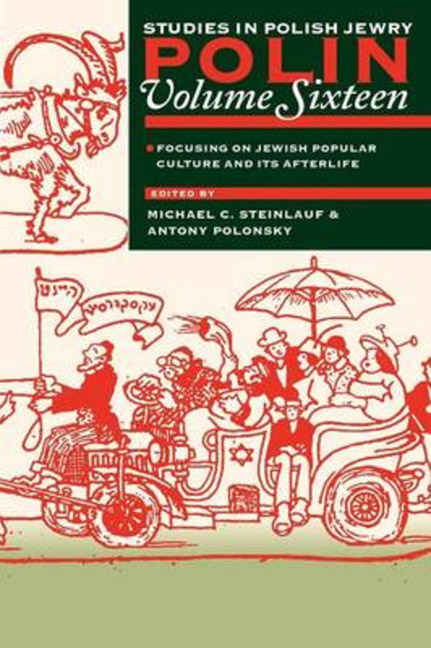Book contents
- Frontmatter
- Dedication
- Editors and Advisers
- Preface
- Polin
- Polin: Studies in Polish Jewry
- Contents
- Note on Place Names
- Note on Transliteration
- PART I JEWISH POPULAR CULTURE IN POLAND AND ITS AFTERLIFE
- IN PRE-WAR POLAND
- AFTERLIFE
- PART II DOCUMENTS
- A. Litvin: Chronicler of Jewish Souls
- Excerpts from Yidishe neshomes
- Urke Nachalnik: A Voice from the Underworld
- Excerpts from Życiorys własny przestępcy
- PART III NEW VIEWS
- PART IV REVIEWS
- REVIEW ESSAYS
- BOOK REVIEWS
- CORRESPONDENCE
- OBITUARIES
- Notes on the Contributors
- Glossary
- Index
A. Litvin: Chronicler of Jewish Souls
from PART II - DOCUMENTS
- Frontmatter
- Dedication
- Editors and Advisers
- Preface
- Polin
- Polin: Studies in Polish Jewry
- Contents
- Note on Place Names
- Note on Transliteration
- PART I JEWISH POPULAR CULTURE IN POLAND AND ITS AFTERLIFE
- IN PRE-WAR POLAND
- AFTERLIFE
- PART II DOCUMENTS
- A. Litvin: Chronicler of Jewish Souls
- Excerpts from Yidishe neshomes
- Urke Nachalnik: A Voice from the Underworld
- Excerpts from Życiorys własny przestępcy
- PART III NEW VIEWS
- PART IV REVIEWS
- REVIEW ESSAYS
- BOOK REVIEWS
- CORRESPONDENCE
- OBITUARIES
- Notes on the Contributors
- Glossary
- Index
Summary
SHMUEL HURVITS, whose pseudonym was A. Litvin, was born to a poor family in Minsk in 1862. He educated himself in both Jewish and general subjects, and began to work as a teacher. But an ideological attraction to manual labour led him to give up teaching and work at paving streets, and then to take up such occupations as carpentry, woodcarving, and printing, as well as bookkeeping and peddling. He began to publish articles and poems in the 1890s, first in Russian and Hebrew, then in Yiddish. He moved to the United States in 1901, where he worked in a shoe factory, distributed newspapers, and wrote for the radical Yiddish press such as the Forverts, but in 1905, at the time of the first Russian revolution, he returned to eastern Europe, where he lived in Warsaw and then in Vilna. From 1909 to 1912 in Vilna he edited the left-wing nationalist monthly Lebn un visnshaft (‘Life and Knowledge’), in which he published well-known Jewish writers such as Linetski, Mapu, Shomer, and Bialik, as well as translations from Dickens, Tolstoy, Byron, Shelley, and Lagerlöf; studies in Jewish history and folklore; and works by young Yiddish writers such as Dovid Eynhorn, S. Niger, and Leyb Naydus.
In 1911–12 Litvin began to publish articles based on his travels throughout eastern Europe beginning in 1905. After returning to the United States in 1914, he published these articles in a six-volume anthology entitled Yidishe neshomes (‘Jewish Souls’). In scores of sketches of badkhonim, purim-shpilers, wandering preachers, and musicians; healers and holy men; beggars, pickpockets, and thieves in towns and cities throughout Poland, Lithuania, and Galicia, Litvin constructs an extraordinary panorama of the life of the Jewish masses at the moment when centuries-old traditions engaged modernity and either changed or vanished. He documents this world in the interests of a new generation of Jews who, he believed, needed such knowledge to build a secular yet authentically Jewish modern culture.
Litvin was also a dedicated political and social activist, one of the pioneers of the Po'alei Tsion movement, first in eastern Europe and then in the United States. He was a founder of the Jewish co-operative farming community Harmonya in Plainfield, New Jersey. He continued to contribute extensively to the Yiddish press, focusing on issues such as Jewish education and consumer and credit co-operatives.
- Type
- Chapter
- Information
- Focusing on Jewish Popular Culture and Its Afterlife , pp. 371 - 372Publisher: Liverpool University PressPrint publication year: 2003

